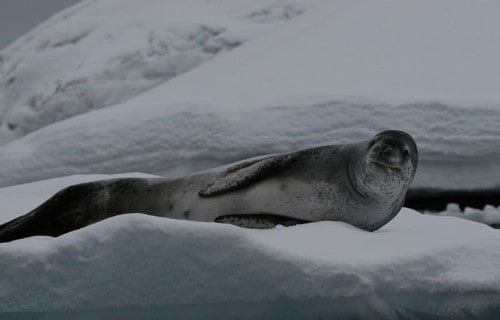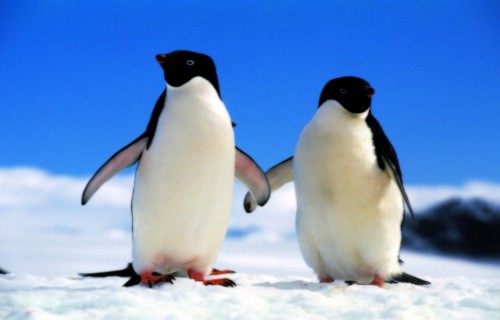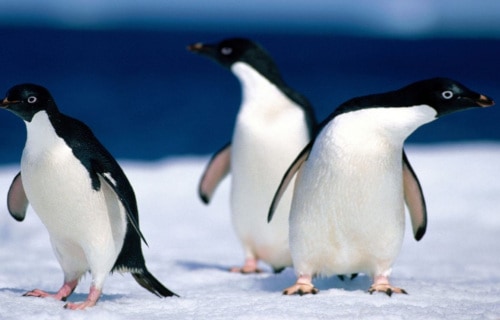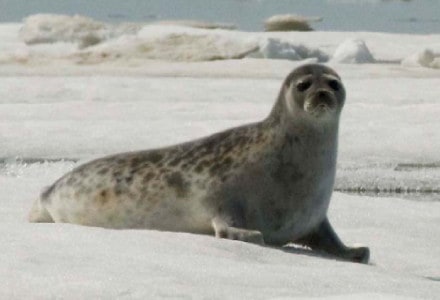
7 Astounding Polar Creatures
Nature thrives in virtually all regions of the globe, even those many people consider to be incapable of surviving a thriving ecosystem. Such is the case with these, our choices for 7 Astounding Polar Creatures. Certainly, they represent only the tip of the iceberg, so to speak, when it comes to life in these regions. We hope you enjoy reading about them and join us in supporting efforts to preserve them and their native environment.
Adelie Penguin

Adelie Penguin Facts
- The Adelie Penguin is a blue-eyed species of penguin common along the entire coast of Antarctica which is its only natural habitat. This remarkable bird remains among the most southerly distributed of all seabirds.
- The bird bears the name of Adelie Land, a claimed territory on the continent which in turn was named after the wife of French explorer Jules Dumont d’Urville. It was he who discovered these Penguins in 1840.
- The Adelie Penguin represents one of three species in the genus Pygocelis. DNA evidence suggests that the genus split from other penguins around 38 million years ago.
- In turn, this penguin split off from the other members of the genus around 19 million years ago.

Adelie Penguin Physical Description
The Adelie Penguin constitutes a mid-sized animal which attains a maximum height of about 30 in. (75 cm). In weight, the adults average 13.2 lb. (6 kg).
A genetic trait appears in the form of a distinctive white ring surrounding the eye and the feathers at the base of the bill. These long feathers hide most of the red bill.
The tail grows slightly longer than that of other penguins. At this weight and height, the animal measures slightly smaller than other penguin species.
The Adelie Penguin also has the rather remarkable ability to swim at speeds of up to 45 mph (72 kph).
- Kingdom: Animalia
- Phylum: Chordata
- Class: Aves
- Order: Sphenisciformes
- Family: Sphensicidae
- Genus: Pygoscelis
- Species: P. adeliae
Adelie Penguin Habitat and Distribution
The Adelie Penguin population inhabits the coastline of the Antarctic continent. However, very few penguins appear to breed in the quarter of the continent eastwards of the Antarctic Peninsula. Only a few small colonies are present in this region.
While the breeding season lasts, the unique animal congregates in large colonies some of which number over a quarter of a million pairs. Individual colonies can vary dramatically in size with some particularly vulnerable to climate change.
The Adélie Penguin breeds during the Antarctic summer so from October to February on shores around the continent. This seabird will build rough nests of stones and lay on average two eggs.
Both parents take turns incubating the eggs for 32 to 34 days. The chicks remain in the nest for 22 days before joining nurseries where they cannot yet enter the seas. The chicks will molt into their juvenile plumage and go out to sea for the first time after roughly 50 to 60 days.
CL: http://bit.ly/2xQPH8p
Adelie Penguin Diet and Migration
The Adelie Penguin primarily feeds upon ice krill, Antarctic krill, and Glacial Squid. Its diet varies widely depending on the geographic location during the chick-rearing season.
Evidence indicates that the animal once fed primarily upon fish. However, approximately 200 hundred years ago the seabird began to switch to a mostly krill-based diet, which may be the direct result of fewer numbers of its chief competitors for the local fish supply. This happened when the numbers of baleen whales and fur seals began to decline due to hunting.
The Adelie Penguin can migrate an average 8,100 mi (13,000 km) during the year. It follows the sun from the breeding colonies to winter foraging grounds and back again. The longest recorded migrations have been as much as 10,900 mi (17,600 km).
Bowhead Whale
CL: http://bit.ly/2xLZ0ap
Bowhead Whale Facts
- Science considers the majestic Bowhead Whale to be a species of baleen whale. This ocean dweller once served as an early target of whaling practices. Sadly, it also formed a very common target.
- Even though this species was hunted to the brink of extinction, it has fortunately proven to be the exception to the rule. Since the whaling moratorium in 1966, its numbers have rebounded.
- Due to this most welcome increase in numbers, the species now holds a Least Concern status by the IUCN. Since the moratorium, limited subsistence hunting by Native Alaskans has been permitted.
- The most noteworthy fact about this creature remains its apparent lack of migration patterns. This makes it the only known species of baleen whale to spend its entire life within one area.
CL: http://bit.ly/2xQPH8p
Bowhead Whale Physical Description
The Bowhead Whale ranks among the largest known baleen whales. Individuals grow to an average length of approximately 59 ft (18 m).
In fact, this whale displays moderate sexual dimorphism, with females being larger than males. In addition, the bodies grow thick in construction. As a result, individuals may weigh as much as 220,000 lb (100,000 kg).
This species possesses a mottled coloring, combining dark and light patches. The most noteworthy feature, however, continues to be its head which we know to be the largest head of any known creature, relative to body size.
It comprises roughly one-third of its overall body length. It’s also somewhat triangular in shape and individuals use it to break through the ice.
Another distinctive trait is that the animals possess the thickest blubber of any known species.
- Kingdom: Animalia
- Phylum: Chordata
- Class: Mammalia
- Order: Cetacea
- Family: Balaenidae
- Genus: Balaena
- Species: B. mysticetus
CCL: http://bit.ly/2xQPH8p
Bowhead Whale Distribution, Habitat, and Ecology
The Bowhead Whale inhabits a range restricted to the arctic and sub-arctic waters. The animal does move across the entire range but does not migrate as such.
Its motions seem to be determined by climate change and the movements of ice. Individuals do not seem to be deep divers, and rarely dive more than 500 ft (152 m).
The Bowhead Whale does not appear to be an especially social species. It typically travels alone or in groups of no more than six individuals.
Since it feeds as a filter feeder, it swims with its mouths open wide and feeds on zooplankton, including copepods, amphipods, and other small crustaceans. Each individual consumes an average of 3,600 lb (1,633 kg) per day.
Females reproduce every 3-4 years on the average. The Bowhead Whale still represents one of the longest-lived creatures on earth – an average lifespan is about 200 years.
Snowy Owl
CCL: http://bit.ly/2REt4fw
Snowy Owl Facts
- The truly magnificent Snowy Owl represents a rather large species of owl, despite the harshness of its habitat. It remains easily recognized for its distinctive features.
- This also forms one of the largest known species of owl. On average, individuals also commonly rank as the heaviest owl species as well.
- The bird possesses thick plumage, heavily feathered feet with claws, and distinctive color patterns. These render the Snowy Owl well-adapted for life north of the Arctic Circle.
Snowy Owl Physical Description
The eyes of the stunning Snowy Owl most commonly display a brilliant yellow, contrasting sharply with the black beak and white feathers.
Most adult males appear virtually pure white, but females and young birds have some dark markings. A young member of the species is also heavily barred, and dark spotting may even predominate.
The bird sometimes reaches a length of as much as 28 in (71 cm). Its wingspan may be up to 59 in (150 cm). Individuals may weigh almost 6.6 lb (3 kg).
- Kingdom: Animalia
- Phylum: Chordata
- Class: Aves
- Order: Strigiformes
- Family: Strigidae
- Genus: Bubo
- Species: B. scandiacus
CCL: http://bit.ly/2xQPH8p
Snowy Owl Distribution, Habitat, and Ecology
The beautiful Snowy Owl nests in the Arctic tundra of the northernmost stretches of Alaska, Canada, and Eurasia. Most winter south through Canada and northern Eurasia, with a presence occurring further south in some years.
Most of the birds like open areas like coastal dunes and prairies that appear somewhat similar to tundra. The animals have been reported as far south as the American states of Texas, Georgia, the American Gulf states, southernmost Russia, and northern China.
The owl is a powerful animal for its size. It primarily preys on lemmings and other small rodents for food during the breeding season. However, at times of low prey density, or during the nesting period, it may switch to favoring juvenile ptarmigan.
The birds are opportunistic hunters and prey species may vary considerably, especially in winter. It feeds on a wide variety of small mammals such as meadow voles and deer mice.
The Snowy Owl will take advantage of larger prey as well. Some of the larger mammal prey includes hares, muskrats, marmots, squirrels, rabbits, raccoons, prairie dogs, rats, moles, and smaller birds.
The owl will also take fish from the surface of lakes. Each bird must capture roughly 7 -12 mice per day to meet its food requirement and can eat more than 1,600 lemmings per year. Like many other birds, the Snowy Owl swallows its prey whole.
CCL: http://bit.ly/2xQPH8p
Snowy Owl Threats
Though Snowy Owls have few predators, the adults are very watchful and are equipped to defend against any kind of threat towards them or their offspring.
During the nesting season, the owls regularly defend the nests against arctic foxes, corvids, and swift-flying jaegers. Other threats include dogs, gray wolves and avian predators.
In addition, males defend the nest by standing guard nearby while the female incubates the eggs and broods the young.
Both sexes attack approaching predators, dive-bombing them and engaging in distraction displays to draw the predator away from a nest.
Leopard Seal
CCL: https://bit.ly/3Af0bNt
Leopard Seal Facts
- Don’t let the seemingly gentle appearance of the Leopard Seal fool you. This rather amazing animal ranks as the second leading predator in all of Antarctica.
- The animal draws its name from the presence of numerous spots on its body. This ocean-dwelling creature also represents the second largest species of seal in the Antarctic.
- The species remains well-known for switching from playfully curious behavior to dangerous aggression without warning. So, not something you want to approach in the water to pet.
- Though not generally threatening to humans, individuals have been known to attack divers.
Leopard Seal Physical Description
The remarkable Leopard Seal is both large and powerful – a dangerous combination. A slight degree of sexual dimorphism is present, with the females generally slightly larger in size than the males.
The animal attains a length of as much as 11.5 ft (3.5 m) and weighs up to 1,320 lb (600 kg).
In addition to the omnipresent spots, the seal is a light gray in color on the stomach and a darker gray on the back.
The front teeth of this powerful carnivore are razor sharp – so, consider them cute from a distance. An interesting (unless you are their prey) adaptation locks their molars together in a way that allows them to filter krill from the water when larger prey is unavailable.
- Kingdom: Animalia
- Phylum: Chordata
- Class: Mammalia
- Order: Carnivora
- Family: Phocidae
- Genus: Hydrurga
- Species: H. leptonyx
CCL: http://bit.ly/2xLZ0ap
Leopard Seal Distribution, Habitat, and Behavior
The Leopard Seal lives exclusively in the extremely cold waters of Antarctica though it will migrate within that overall region. Individuals divide their time between the ice packs and the upper portions of the ocean, never diving very deep.
The seals live a primarily solitary life, except during mating season. During the spring and summer, it will spend long periods of time underwater, vocalizing which is perhaps part of the mating ritual. After mating, the female gives birth to a single pup.
The Leopard Seal is an opportunistic predator. The prey most commonly includes penguins, squid, fish, and even other species of seals.
Narwhal
Narwhal Facts
- The rather remarkable Narwhal, Monodon monoceros, sometimes called the narwhale, ranks as a medium-sized toothed whale and the animal with the largest canines on the planet.
- The mammal grows to be a medium-sized whale, or around the same size as related species. Total length in both sexes, excluding the tusk of the male, can range from 13-18 ft. (4-5.5 m).
- Typical adult body weight measures between 1,800-3,500 lbs (800-1,600 kg).
- Males attain sexual maturity at 11 to 13 years of age, when they reach roughly 13 ft (4 m) in length, while females do so at 5 to 8 years old when they reach about 11 ft (3.3 m) long.
Narwhal Physical Description
The pigmentation of the Narwhal develops as a mottled pattern, with blackish-brown markings over a white background, unlike any other species of whale in any ocean.
The coloring of the creature appears darkest at birth, becoming whiter in color with age. White patches develop on the navel and genital slit at sexual maturity. Old males may be almost pure white.
Narwhals do not have a dorsal fin – possibly an evolutionary adaptation to swimming easily under ice. In addition, the neck vertebrae do not fuse together but stay jointed, like those of land mammals. Both these characteristics are shared by the beluga whale, a fellow inhabitant of icy Arctic seas.
While the tail flukes of female narwhals have front edges that sweep back, those of males have front edges that are more concave and lack a sweepback. This is an adaptation for reducing drag caused by the tusk.
- Kingdom: Animalia
- Phylum: Chordata
- Class: Mammalia
- Order: Artiodactyla
- Family: Monodontidae
- Genus: Monodon
- Species: M/monoceros
Narwhal Tusks
The most conspicuous characteristic of the male narwhal remains its single extremely long tusk. This actually represents a canine tooth that projects from the left side of the upper jaw, through the lip and forms a left-handed helix.
The tusk grows throughout life reaching lengths of as much as 10 ft (3.1 m). Despite its formidable appearance, the tusk is hollow and weighs only about 22 lbs (10 kg).
About one in 500 males has two tusks, which occurs when the right canine, normally small and less straight, also grows out through the lip.
Females may grow tusks sometimes, although the evidence on the frequency of this is somewhat conflicting. The tusks are surrounded posteriorly, ventrally, and laterally by several small teeth which vary in morphology and histology.
These teeth are vestigial and never erupt from the lip, as such the Narwhal’s mouth appears toothless.
CCL: https://bit.ly/24dGLTK
Narwhal Distribution and Diet
The animal inhabits predominantly the Atlantic and Russian areas of the Arctic Ocean. Individuals also commonly appear in the northern part of Hudson Bay, Hudson Strait, and the Baffin Bay – off the east coast of Greenland.
The Narwhal often visits a strip running east from the northern end of Greenland round to eastern Russia. Additionally, the northernmost sightings of narwhal have occurred north of Franz Joseph Land.
Most of the world’s narwhals inhabit the fjords and inlets of Northern Canada and western Greenland.
They are able to survive diving to rather incredible depths of up to 4,900 ft (1,500 m) below sea level.
The Narwhal has a relatively restricted and specialized diet. Its prey predominantly includes halibut, cod, shrimp, cuttlefish, and arm hook squid. Additional items found in its stomach have included capelin, wolffish, and sometimes rocks, accidentally ingested when whales feed near the bottom.
Due to the lack of well-developed dentition in the mouth, Narwhals most likely feed by swimming towards prey until it is within close range and then sucking it with considerable force into the mouth.
Arctic Fox
Arctic Fox Facts
- The truly beautiful and amazing Arctic Fox constitutes a small species of fox that evolved as native to the Arctic regions of the Northern Hemisphere.
- The species is generally active from early September until early May. It tends to live and breed in complex underground tunnel systems. After mating, the female may give birth to between 5-25 kits at once.
- Both sexes share in the raising of the young. In a unique pattern, after the young have reached a certain age, the females leave the family to form their own groups.
- Unlike most animals, the male remains to finish rearing the young.
- This amazing creature also remains the only land mammal endemic to Iceland.
Arctic Fox Physical Description
The gorgeous Arctic Fox displays a moderate degree of sexual dimorphism. The males generally develop somewhat larger than the females.
An average body length between the two genders measures about 43 in. (110 cm), plus an average tail length of 12.2 in. (31 cm).
The lovely animal also averages roughly 7.7 lbs. (3.5 kg) in weight, but rather exceptional individuals may weigh as much as 21 lbs. (9.4 kg).
Its thick coat of fur changes color with the seasons to blend in with the environment – brown in the summer season and white during the winter.
- Kingdom: Animalia
- Phylum: Chordata
- Class: Mammalia
- Order: Carnivora
- Family: Canidae
- Genus: Vulpes
- Species: V. lagopus
Arctic Fox Distribution, Habitat, and Ecology
The Arctic Fox appears to remain quite common throughout the Arctic tundra biome, as well as other cold regions of the Northern Hemisphere.
It commonly inhabits tundra habitats in Asia, Europe, and North America.
It has adapted to this environment by growing beautiful thick fur and a generous amount of body fat. The thick fur on its paws allows it to walk on the ice in pursuit of food without the loss of body heat.
It is an opportunistic omnivore and will eat virtually anything. In addition to consuming any small prey it can catch, it will occasionally feed on berries, seaweed, and the occasional fish.
Its own natural predators include golden eagles, red foxes, grizzly bears, and wolves.
Beluga Whale
Beluga Whale Facts
- The Beluga Whale, also popular as white whale and Delphinapterus leucas, is an extremely distinctive whale, and an Arctic and sub-Arctic cetacean.
- It is one of two members of the family Monodontidae, along with the narwhal, and the only member of the genus Delphinapterus.
- This white whale is famous as melonhead, beluga or sea canary due to its high-pitched twitter.
- he Delphinapterus leucas adapted to life in the Arctic, so has a number of anatomical and physiological characteristics that differentiate it from other cetaceans.
- Among these are its unmistakable all-white coloring, and the absence of a dorsal fin.
Beluga Whale Physical Description
The beluga’s body size is between that of a dolphin’s and a true whale’s, with males growing to a length of approximately 18 ft (5.5 m) long and weighing up to 3,500 lbs (1,600 kg).
The white whale has a stocky body as well as the greatest percentage of blubber. Its sense of hearing is highly developed and thanks to the echolocation, it can move about and find blowholes under sheet ice.
Its body is round, particularly when well fed and tapers less smoothly to the head than the tail. The sudden tapering to the base of its neck gives it the appearance of shoulders, unique among cetaceans.
The tail fin grows and becomes increasingly and ornately curved as the animal ages. The flippers are broad and short, making them almost square-shaped.
It also possesses a distinctive protuberance at the front of its head which houses an echolocation organ called the melon. In this animal, that organ is large and deformable.
- Kingdom: Animalia
- Phylum: Chordata
- Class: Mammalia
- Order: Artiodactyla
- Family: Monodontidae
- Genus: Delphinapterus
- Species: D. leucus
Beluga Whale Distribution and Behavior
Belugas remain gregarious and form groups of up to 10 animals on average. During the summer months, individuals can gather in the hundreds or even thousands in estuaries and shallow coastal areas.
The species is a slow swimmer but can dive down to as much as 2,300 ft (700 m) below the surface of the ocean.
Delphinapterus leucas evolved as an opportunistic feeder and its diet varies according to the locations and the season. It mainly eats fish, crustaceans and other deep-sea invertebrates.
The majority of belugas live in the Arctic and the seas and coasts around North America, Russia, and Greenland. Its worldwide population is thought to number around 150,000 individuals.
The animals are migratory and the majority of groups spend the winter around the Arctic ice cap. When the sea ice melts in summer, most move to warmer river estuaries and coastal areas. Some populations are sedentary and do not migrate over great distances during the year.
Unfortunately, Belugas are one of the cetaceans most commonly kept in captivity in aquariums and wildlife parks in North America, Europe, and Asia. It remains popular with the public due to its color and expressiveness. We do not approve of anybody keeping wild animals for entertainment.
CCL: http://bit.ly/2zDnGC2
Beluga Whale and Integumentary Distinctiveness
The adult Beluga rarely gets mistaken for any other species because it is completely white or whitish-grey in color. Calves, however, are usually gray and by the time they are a month old, they have turned dark gray or blue-gray.
These then start to progressively lose their pigmentation until they attain their distinctive white coloration, at the age of seven years in females and 9 in males.
The white coloration of the skin is an adaptation to living among ice in the Arctic that allows belugas to camouflage themselves in the polar ice caps as protection against their main predators, polar bears, and killer whales.
Unlike other cetaceans, a beluga seasonally sheds its skin. During the winter the epidermis thickens and the skin can become yellowish, mainly on the back and fins.
When it migrates to the estuaries during the summer, it rubs itself on the gravel of the riverbeds to remove the cutaneous covering.
CCL: https://bit.ly/3Af0bNt
7 Astounding Polar Creatures
We hope you have enjoyed this listing of our choices for 7 Astounding Polar Creatures. Each and every one we have listed, and indeed the myriad others, as well, represent marvelous forms of life. But we must do all we can to protect and preserve them and their environment, else our descendants might not have the pleasure of enjoying them as we do. We must always be mindful of the fact that our actions affect the world around us, and those creatures that share it with us.
Check out our other articles on 6 Startling Evolutionary Adaptations, 7 Dazzling Desert Dwellers, Wonderful Wild Cats of the World

